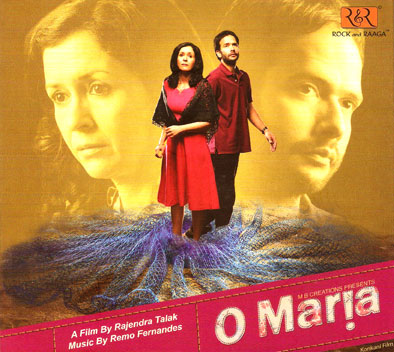 [A music review by Rocky Lazarus as published in The Gomantak Times]
[A music review by Rocky Lazarus as published in The Gomantak Times]
I have been listening to Remo Fernandes’ original music from the film O Maria. The CD is produced by M.B. Creations and marketed by Rock and Raaga. I discover something artistically and musically new with each hearing. The lyrics by Saish Poi Palondikar are refreshing, and often humorous. They have been perfectly fitted onto Remo’s lilting melodies by this able wordsmith.
Track 1: Laranchim Cantaram is a modern ballad which manages to absorb traces of the old Goan ‘cantaram’ style, and in which Remo has encapsulated every Goan’s desire to preserve the State in its pristine condition for posterity. When I asked Remo “Could you share your experience while working on the music for ‘O Maria’?”, he replied:
“I love working on several different kinds of music. But whenever I work on Goan Konkani compositions, there’s an element which kicks in which I cannot describe; it is like an emotional and spiritual home-coming, even though I must say I am not primarily a composer of Goan music.”
As the pleasing sounds of guitars drift in, Remo’s mellifluous voice follows with the words ”Lara laramchim…aik tim cantaram…”
An imaginative chord progression makes this song a treat for the ears. Especially at the chorus with its powerful funk-rock feel of the drums, rolling into a crescendo and substituting the side-stick with a full snare-hit. The bass on this track is what drives the song much more than the other instrumentation, harmony and vocals. Remo has played it live on a real bass guitar with superb articulation on the chorus. Listen to Remo’s characteristic flute style in the middle solo which suddenly takes the listener to a different height, while the bass guitar playfully does delightful slide-fills in between phrases. The song ends on a soft ad-lib coda and a beautiful C major 9 strummed chord.
Track 2: Surganchi Fati is a duet-dulpod sung by Remo together with Queenie Fernandes from Siolim. Describing her experience with the O Maria recording Queenie said:
“Singing with Remo was a dream come true, as was my debut as a playback singer. They were two great lovely things happening to me at the same time. Amazing time; amazing experience! The music is just fantastic, hats off to Remo for the great work.”
As the song plays on, pizzicato strings add to the bouncy feel of the track. The peppy flute solos complement the singing. Watch out for the girl cautiously whispering “Shhhhh… xezari choitolo…” when the boy sings “Mog amcho fultolo… taka vannani martolo…”. This song has a lot of instruments/tracks but surprisingly each one emerges independently to the fore from their respective spatial positions and depths. Great job by San, the mixing engineer. After the twin harmonized flute solo one is taken by surprise again at 3:05 by the harmonic vocal counter which then fades out gently in a smooth linear graph.
Track 3: Maka Naka Tuka Naka is a powerful full-on definitive hard rocker in both the normal and latter half time feel. Incidentally Remo’s sons, Noah and Jonah are rock musicians and composers themselves, and this song is bound to make them smile. I’m listening to a power-chord backing in G5 and guitars and bass riffing together. The lyrics of the catchy chorus [both Konkani and English] have been written by Remo keeping Goa’s problems in mind, and have been sung by him in four-voice harmony in a tight staccato. A track of this order had to come one day from Remo. It has an overdriven guitar riff which sticks in your brain, while the bass guitar has intricate melodic lines throughout the track.
It is unbelievable how a Konkani song has been made to sound so modern. The mix is very well calculated. I have monitored this song initially on a good Sennheiser headphone set at half volume with the graphic equalizer set to flat. And now am listening to it on a low-end head set while writing this. The stereophonic manipulation of instruments is smart. I am hearing different musical ideas jumping at me at different times; a great song for the young generation. This bilingual track will be much appreciated by rockers and may soon be heard being covered by bands in Goa and played by DJs all over.
To a question, “Which do you think is your best track among the four songs and why?” Remo replied:
“That’s like asking a parent which of his four children is his favorite! I love them all for different reasons. However, I’m particularly disappointed that “Maka Naka” was removed from the film after being excellently picturized and edited. It would have made Konkani cinema history, being the first all-out Konkani hard rock song ever. But then I guess when a film maker thanks the Chief Minister in the first frame of his film, and invites him as chief guest to launch the CD, he ties his own hands up, and can’t quite include a song about corruption in the film.”
Track 4: Adieus Mai is a highly emotional requiem. It is evident from the music that Remo has worked on this with his heart and soul. Those who know him closely will at once realize that it’s a personal belated tribute to his own dear mother. I love the way the layered piano changes timbre on different notes at different velocities with a nimble hand. The organ fills the whole audio spectrum without its often over-sonorous tone. And when the female voices appear in complete harmony, they feel like drops of water on a thirsty soul’s parched throat. The angelic combination of the young voices of Chriselle Mendonsa and Shine Fernandes, both from Santa-Cruz, has added to the beauty of the album. About their experience regarding this project, Shine says: “It was a huge privilege and a great experience working with Remo – someone who has been a great inspiration to all of Goa. My family and I absolutely love the music of O Maria. It has this unique Goan touch to it and makes you want to hum the tune over and over again.”
Chriselle says: “It was a good experience singing for the album O Maria. It was a great achievement for me to sing for a movie for the first time. The music was awesome. Congratulations to Remo; my friends love the album and I would love to sing on more music albums in the future.”
The powerful tutti at 2:40 is certain to arouse a strong feeling of sadness in the listener when the timpani come in hand in hand with the buzz roll of the snare, and the distant trumpet heralds a counter-point. In the end, the flowing notes of the bell-tree, with fading echoes reminiscent of tolling bells from this world to the other side of the thin parting veil, complete the journey of her soul.
The film: I have watched O Maria, and am fairly impressed by the direction, casting, acting, script and the whole movie in general. And the music of Remo Fernandes seems to have greatly enhanced the film maker’s vision. I feel Remo has done all he could to raise the music of O Maria to the level of an award-winning score. And let us not forget that, in his usual trade-mark style, Remo has played every instrument on these tracks, sung every voice other than the female ones mentioned above, and has played the role of recording and pre-mixing engineer. A true labor of love.
—ROQUE LAZARUS
